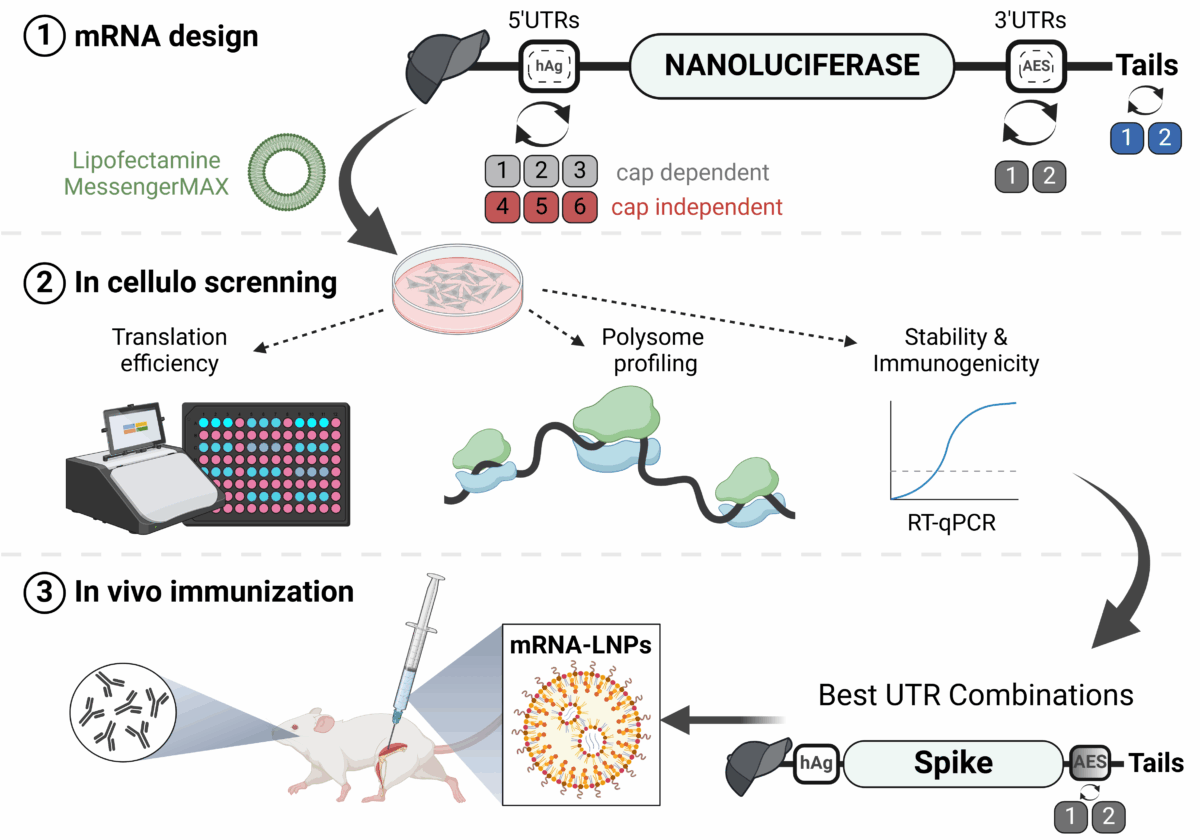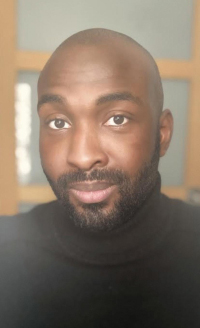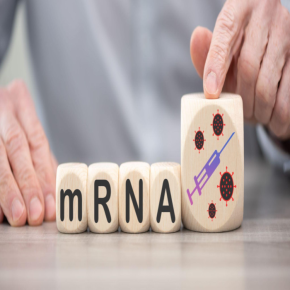Typologie d'actualités: Group Molecular assemblies and complex systems
Stronger RNA building blocks for tomorrow’s vaccines

Messenger RNA (mRNA) has emerged as an attractive new technology of drugs. The efficacy of mRNA technology depends on both the efficiency of mRNA delivery and translation. Untranslated regions (UTRs) and the poly(A) tail play a crucial role in regulating mRNA intracellular kinetics. Intending to improve the therapeutic potential of synthetic mRNA, CBM researchers evaluated various UTRs and tail designs, using Pfizer-BioNTech COVID-19 vaccine sequences as a reference. First, they screened six 5’ UTRs (capdependent/independent), evaluated nine 5’ UTR-3’ UTR combinations, and a novel heterologous A/G tail in cell models, and in vivo using luciferase as a reporter gene.
Then, to decipher the translation mechanism of selected UTRs, they correlated mRNA expression with ribosome load, mRNA half-life, mRNA immunogenicity, and UTR structures. Results showed that the heterologous tail they introduced is as potent as the Pfizer-BioNTech tail and confirmed the high potency of the human α-globin 5’ UTR.
They also revealed the potential of the VP6 and SOD 3’ UTRs. Researchers validated their results using mRNA encoding the SARS-CoV-2 spike protein formulated as lipid nanoparticles (LNPs) for mouse immunization. Overall, the selected 3’ UTRs and heterologous A/G tail have great potential as new elements for therapeutic mRNA design.
These results open up new prospects for mRNA therapies. While improvements are still needed to achieve higher expression than existing strategies, this strategy contributes to improving mRNA therapies.
These results are linked to a patent
These major advances were reported by CNRS Chemistry in its scientific news.
Reference:
Evaluation of synthetic mRNA with selected UTR sequences and alternative Poly(A) tail, in vitro and in vivo.
Medjmedj A, Genon H, Hezili D, Ngalle Loth A, Clemençon R , Guimpied C, Mollet L, Bigot A, Wien F, Hamacek J, Chapat C & Perche F
Molecular Therapy Nucleic Acids 2025. DOI: 10.1016/j.omtn.2025.102648
2025, September 16: Swati Biswas seminar

Albert NGALLE-LOTH’s thesis defence – 3 June 2025

Combination of nanomedicine and biophysics methods to characterize mRNA liposomes

This new optimised version of liposomes has been reported by CNRS Chimie on its website.
The development of lipid-based mRNA delivery systems has significantly advanced mRNA-based therapies. Liposomes, in particular histidylated liposomes (LYX), have been shown to be effective in delivering nucleic acids. In this study, LYX liposomes were optimised by adding a freeze-drying and extrusion step, resulting in improved homogeneity and storage stability. LYX liposomes maintained their size (150 ± 10 nm) and polydispersity index (0.10 ± 0.02) for up to a year at 4°C, while preserving their transfection efficiency. They exhibit a high mRNA encapsulation rate (∼95%) and protect it from degradation by RNases. The lamellar organisation was confirmed by small-angle X-ray scattering and CryoTEM. These liposomes allow efficient transfection of cell lines and primary cells, albeit with lower efficiency than commercial vectors, due to slower cell internalisation and reduced endosomal escape. They have demonstrated their ability to deliver mRNA encoding the therapeutic molecules BMP2 and BMP9, leading to the production of functional proteins capable of inducing BMP signalling. In vivo studies have also confirmed their potential for mRNA delivery when incorporated into hydrogels and implanted subcutaneously in mice. These results show that LYX liposomes are a promising and versatile platform for mRNA delivery in therapeutic applications.
This work involved laboratories from two institutes: the Centre de Biophysique Moléculaire (CNRS Chimie) and the Laboratoire de Biologie, Bioingénierie et Bioimagerie Ostéo-Articulaires (CNRS Ingénierie).
Reference:
Albert Ngalle Loth, Manon Maroquenne, Ayoub Medjmedj, Franck Coste, Thomas Bizien, Chantal Pichon, Delphine Logeart-Avramoglou, Federico Perche.
Structural and functional characterization of a histidylated liposome for mRNA deliveryStructural and functional characterization of a histidylated liposome for mRNA delivery.
Journal of Controlled Release (2025) Volume 379, pages 164-176, doi: 10.1016/j.jconrel.2025.01.010.
2 job offers open at CBM!

Welcome to Nikola Baslerova !

Doctoral student Nikola Baslerova is joining the “Molecular Assemblies and Complex Systems” team for a 3-month Erasmus stay, as part of a collaboration with the University of Pardubice in the Czech Republic.
Currently in her third year of doctoral studies, she carries out her research in the field of microbiology, but collaborates with chemists. The title of her thesis is “Determination of the biological activity of boranes and heteroboranes”.
At CBM, she studies the cytotoxicity of certain synthetic molecules, in particular complex, polyhedral boranes and heteroboranes. These compounds are of potential interest for certain biomedical applications, which are currently being explored.




